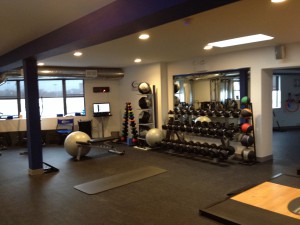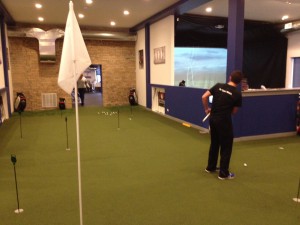Back to the drawing board. . .
This is where the double-sided approach of a golf-improvement facility like Catalyst comes into play. If the actual golf-improvement stuff isn’t going well, you can look to the fitness side.
My swing mechanics are a struggle, so I will dig in on the flexibility and balance drills that will improve my chances of making better swings. At the very least, that’s a great place to channel out that frustration energy.
As an extra measure, I ramp up my workouts with some treadmill and some exercises from Liz’s trainer.
My right hip is sore. But it seems more inclined to fire out when I make move to the ball. If that’s true, that’s a good tradeoff.
A couple of days later, when my next session with Joe rolls around, I’m renewed and ready to get back at it.
I hand him my iPhone and show him the swings my wife has videotaped at the Golf Dome.
“Most of them were bad,’’ I say. “But there were a couple of not-terrible ones at the beginning. Before I reverted to form.’’
Joe looks at the video briefly, then says, “You probably shouldn’t hit balls. Just work on your drills. Hitting balls, you’re bound to get frustrated.’’
Tell me about it. . .
“What you need to do is focus on the process, not the results,’’ he says. “I hope you understand that.’’
Understand it? That’s a phrase I heard Mike Keenan use often when I was covering the Blackhawks and he was their hard-headed, successful coach. He usually used it when the team was in a rare losing streak. As in, “They were focusing on the results, rather than the process.’’
I’m all in for that. We’re in Chicago. There’s snow on the ground, and more on the way. What better time to tear apart an unsavory golf swing and try for something better?
One thing I like about Joe’s approach is that while his drills are designed with optimal swing characteristics in mind, I can tell that he’s often stepping back, looking at what’s realistic and what teaching approach might work best with each individual’s set of issues.
What I really would like to do is put both of us in a time machine, go back 40 or 50 years, and have him give lessons to my 12-to-14 year-old self. That would be the me who has no bad habits and abundance of energy and flexibility, rather than the other way around.
But that’s not happening, so we go through the progression: Firm chip shots with an emphasis on lower body, stepping into the ball to ingrain the right clubhead path and swinging out of my shoes to generate clubhead speed.
It is not going well.
We take a break and go to the mirror, where Joe has me do some fire-the-hip drills, where I’m supposed to let my hips fire on the downswing. I try this dutifully in hopes that will become second nature. I have serious doubts about that, but trust that even if I can absorb a little bit of the lower-body stuff, it could go a long way.
That is my story and I am sticking to it.
We go back and forth between the mirror and the Trackman, where I energetically hurtle my arms—and any other body parts that want to tag along—at the ball.
All of this effort is still only producing 102-yard 9-irons and 202-yard drivers—and those are the good shots.
“Realistically, this could take a year,’’ Joe says, “given your age and what we’re working with.’’
I understand that. I also understand that, I had run out of ideas for a better golf swing. All the little tweaks I had made in the past weren’t working any more.
This was no longer a case of sighing when people out drove me by 40 or 50 yards and not worrying about that because I was going to outscore them around the green.
“I know what you’re saying,’’ I told Joe. “I don’t want you to get discouraged, either.’’
“I never get discouraged,’’ he said. “But I am realistic.’’
I grasp that. The realist in me says, “I’m 62, overweight and coming off radiation that has apparently done some things to my hips and legs that could be affecting my flexibility, strength and balance. This program is going to help my fitness so that I can keep doing all kinds of activities. Improved golf is just one piece in that puzzle.’’


